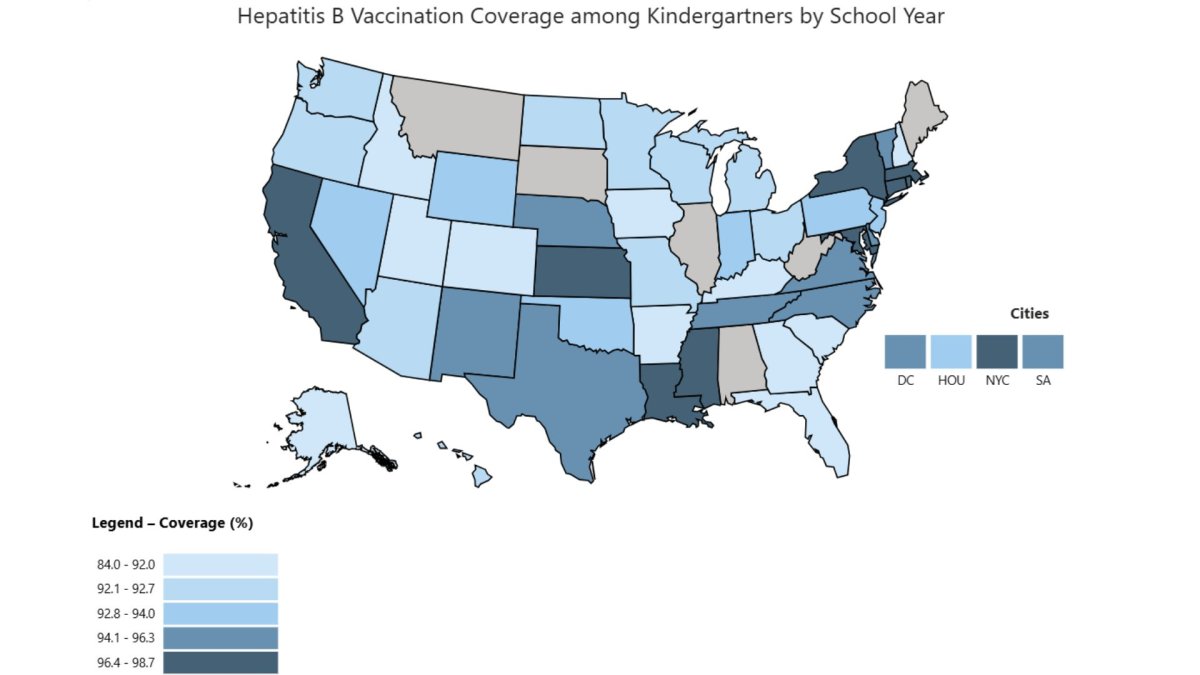-
Royals vs. Blue Jays Highlights | MLB on FOX - 27 mins ago
-
How to Watch Detroit Tigers vs Philadelphia Phillies: Live Stream Sunday Night Baseball, TV Channel - 30 mins ago
-
At least 68 migrants dead and 74 missing after boat capsizes off Yemen coast - about 1 hour ago
-
Yankees’ Jazz Chisholm Jr. Has Defiant Response to Viral Baserunning Blunder - about 1 hour ago
-
Rockies hit back-to-back-to-back home runs, trimming deficit vs. Pirates - about 1 hour ago
-
Tariff rates are “pretty much set,” U.S. trade representative Jamieson Greer says - about 1 hour ago
-
Police investigating Oasis fan death at Wembley Stadium concert - about 1 hour ago
-
OPEC+ Countries Agree to Boost Oil Production: What to Know - 2 hours ago
-
Eli White’s 2 HRs Help Braves Beat Reds in MLB Speedway Classic at Bristol - 2 hours ago
-
How to Watch USATF Outdoor Championships: Live Stream Track and Field, TV Channel - 2 hours ago
Maps Show States With Highest—and Lowest—Kindergarten Vaccination Rates
Data released by the Centers for Disease Control and Prevention (CDC) has revealed the states with the highest and lowest rates of vaccination coverage for multiple vaccines among kindergartners.
Mississippi, New York, Connecticut and Rhode Island had the highest rates of vaccination among kindergartners across the board for the four vaccines: DTP/DTaP/DT, hepatitis B, MMR and polio, while Florida, Idaho, Utah, Colorado, Minnesota and Wisconsin had some of the lowest rates.
The DTP/DTaP/DT vaccine protects against diphtheria, a dangerous bacterial infection, while the hepatitis B vaccine protects against the liver infection.
The MMR vaccine protects against measles, mumps and rubella—infections that can lead to serious complications—while the polio vaccine protects against the infection that can cause paralysis in severe cases.
Newsweek has contacted the CDC via email for comment.
Why It Matters
Vaccine rates have been declining across the country, with all kindergartner coverage for the four vaccines, as well as the Varicella vaccine, having dropped since 2021.
The shifting views on vaccines in recent years, which has gathered momentum after the appointment of Robert F. Kennedy Jr. as Health and Human Services secretary, has sparked concern among health care professionals.
Kennedy Jr., who has been vocal in his vaccination stance, has recently been directing the CDC to change its guidance, from no longer recommending certain vaccines to encouraging patient choice.
A measles outbreak in Texas earlier this year drew particular attention to the issue. After being declared eliminated in the U.S. in 2000, experts pointed to the decrease in MMR vaccine coverage as the reason, with more than 700 cases reported since January.
What To Know
Nationwide, vaccination coverage declined among kindergartners in the 2024-25 school year across all vaccines, while exemptions from one or more vaccines among kindergartners increased.
Exemptions increased across 36 states as well as Washington, D.C., with 17 states reporting exemptions exceeding 5 percent. The national average also increased to 3.6 percent from 3.3 percent the year before.
The findings coincide with measles cases hitting a 33-year high last month, as reported by the CDC, with total cases this year at 1,333. Ninety-two percent of the cases were among unvaccinated people and those whose vaccine status was unknown.
The states with the highest rates of MMR vaccine coverage were Mississippi, New York, California, Connecticut, Maine, Massachusetts and Rhode Island—all of which had vaccine coverage higher than 95 percent among kindergartners.
Idaho had the lowest MMR vaccine coverage at 78.5 percent. It was the only state to have a coverage lower than 80 percent. Alaska, Wisconsin, Minnesota, Kentucky and Georgia were also among the lowest.
For the DTP/DTaP/DT vaccine, rates of coverage among kindergartners were highest in Mississippi, Louisiana, Virginia, Maryland, New York, Connecticut, Maine, Massachusetts and Rhode Island—each with coverage rates over 95 percent.
CDC
Once again, Idaho had the lowest coverage rate—below 80 percent—with Indiana, Georgia, Kentucky and Wisconsin also at bottom end of the ranking.
One state that was not previously in high rankings for vaccine coverage, but was for the hepatitis B vaccine, was Kansas, which showed a significant variation in the coverage between vaccines.
A lot of the same states that had high rates of vaccine coverage for the DTP/DTaP/DT vaccine had high rates of coverage for the hepatitis B vaccine, and the situation was the same for the states with low levels of coverage.

CDC
For the polio vaccine, the rankings were similar to that for the DTP/DTaP/DT vaccine.
There are many reasons for variations between vaccine coverage in states, one being that states that have only medical exemptions for vaccines tend to have higher rates of vaccine coverage, Dr. Paul Offit, director of the Vaccine Education Center and an attending physician in the Division of Infectious Diseases at Children’s Hospital of Philadelphia, told Newsweek.
Meanwhile, states that also allow for “philosophical exemptions or religious exemptions” as well as medical exemptions have lower rates of vaccine coverage, enabling more constituents to opt not to have a given vaccine.
Also, states have different rules on which vaccines they mandate. While the Food and Drug Administration (FDA) licenses a vaccine and the CDC recommends it, it’s up to the state to decide to mandate it, Offit said.
“So that’s why there would be differences, so some states may mandate the DTAP vaccine and other states not,” he said.

CDC
Addressing why vaccine coverage has been going down in recent years, Offit said that there are many factors at play.
One is that “there is much more misinformation and disinformation that is readily available,” he said, pointing to various anti-vaccine advocacy groups and social media.
“It’s just very easy to get bad information out there and it’s much harder to get good information,” he said.
Another factor is that vaccines may not only eliminate diseases, like measles, but also the “memory” of them, Offit said.
“While we eliminated measles from this country by the year 2000, I also think we eliminated the memory of measles. I think people don’t remember how sick, or dead, that virus can make you,” he said.
He added that for as long as people are “not scared of those diseases,” they are not going to feel “compelled” to get the vaccines.
Offit also said that “the pushback is understandable,” given that parents are asked to get their children multiple vaccines throughout the first few years of their lives, with “as many as five shots at one time to prevent a disease most people don’t see using biological fluids most people don’t understand.”
What People Are Saying
Dr. Paul Offit, director of the Vaccine Education Center and an attending physician in the Division of Infectious Diseases at Children’s Hospital of Philadelphia, told Newsweek: “Already, you can see the decline in child health in the present. We have a measles outbreak that’s bigger than anything we’ve had in 33 years. We’ve had three measles deaths in this country. That equals the total number of measles deaths in this county over the last 25 years. We’ve a healthy little 6-year-old girl and a healthy 8-year-old girl dying in West Texas. That’s the first child death in the country since 2003, and that was an immuno-compromised child back then. We’ve had about 260 pediatric deaths from influenza. The last time we’ve seen a number that large was in 2009.”
Source link































